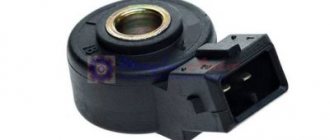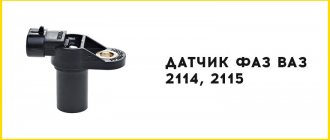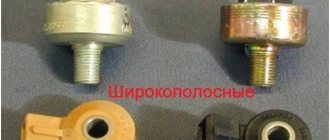The knock sensor (DS) is one of those parts whose importance is difficult to overestimate. The operation of the car's power unit largely depends on its serviceability. Untimely replacement of the element can cause motor failure. In this article we will talk about where the knock sensor is located on the VAZ 2115. We will also list the main signs of failure and describe how to check this part.
What is he responsible for?
The knock controller is a device responsible for vibration in the engine. The functions of the device are as follows:
- track the resulting detonation;
- record problems and send a signal to the computer.
Based on the information received, the ignition timing will change. As a result, detonation will gradually disappear. Without the device, the engine operates in an unstable mode, which leads to increased valve wear.
How dangerous is detonation combustion and what can cause it?
But if at least one of the conditions is not met, then there is a high probability of detonation combustion, which in the future can cause serious damage. The essence of this combustion is that part of the fuel, due to a number of prevailing factors in the combustion chamber, spontaneously ignites. Moreover, this happens before a spark forms between the spark plug electrodes, that is, the mixture ignites ahead of time.
The peculiarity of detonation combustion is that it is similar to an explosion. Combustion of the mixture occurs much faster and is accompanied by increased pressure and significantly higher temperature than during the normal combustion process of the air-fuel mixture.
The result of such combustion is melting of the piston bottom, burning out of it or the valves. In general, detonation in a power plant can cause enormous damage and require expensive and time-consuming repairs.
The cause of detonation may be:
- low-quality gasoline with a low octane number.
- design features of the power plant (compression ratio in the cylinder, shape of the combustion chamber, position of the spark plug, etc.);
- change in operating conditions in the cylinders (incorrect ignition timing, operation under load, the appearance of a significant layer of soot, deterioration in the quality of the air-fuel mixture).
Connection diagram
The sensor connection in 2115 is shown in the figure.
3 wires are connected to the installed device. Inside the device there is a sensing element and a signal converter, which includes an operational amplifier, a bridge circuit and an output stage.
The operating principle of the sensing element is based on the Hall effect. Once the received signal is converted, it is transmitted to the controller.
Independent check and replacement of injection sensors - phases and detonation on VAZ 2114 and 2115 8 valves
VAZ 2114 car engines are equipped with a variety of devices and controllers designed to ensure proper operation of the unit. The performance of the engine and the main systems of the Four depends on their coordinated work. Where is it located and how to replace the VAZ 2114 8 valve phase sensor (DF), as well as the knock sensor (DD)? Detailed instructions are provided below.
Signs of failure of the knock sensor 2115
Fatigue of the device during long-term operation manifests itself as follows:
- reduction in engine power;
- increased fuel consumption;
- increase in unit temperature above normal;
- unstable engine operation;
- the appearance of the smell of gasoline in the car interior;
- The on-board computer displays error codes: 0325, 0326, 0327, 0328.
However, these symptoms do not yet indicate that the sensor has definitely failed. It is guaranteed to occur only when several signs are observed at the same time. After this, the device must be checked. If it really fails, then replacement is required.
DD cost
The knock sensor is a part that, unfortunately, cannot be repaired. If it breaks, you just need to replace it with a new one. The device can be found in most stores with auto parts for VAZ. The average cost of a sensor is 300 rubles. Of course, there are parts that are much more expensive (around 1000 rubles), the price will depend on the manufacturer. However, many car owners note that high cost does not always guarantee reliability and quality. Therefore, there is no point in overpaying. It is better to choose models in the mid-price category. For example, these could be parts produced by the following (Kaluga), Pekar or KRAFT. Judging by the reviews, these domestic brands have proven themselves well, and their products last quite a long time.
In this article, we clearly demonstrated where the knock sensor is located on a VAZ 2115. We described the symptoms of failure of this sensor, and also showed how to check it yourself. If you have any questions, be sure to ask them in the comments.
How to check
Diagnosis of the sensor is first carried out by external examination. Visually, broken wires or oxidation of terminals are immediately noticeable. Troubleshooting restores the operation of the device. Diagnostics of DD is carried out in 2 ways. First method:
- The engine starts.
- The engine operation is brought to 1500-2000 rpm.
- A small metal object is tapped on the sensor body.
- The turnover should increase.
If this is not the case, the element needs to be replaced.
The second method requires a multimeter. Sequence of steps:
- The sensor is removed from the mounting location.
- The multimeter is switched to voltmeter mode and 200 millivolts is set.
- The probes of the device touch the sensor contacts.
- A metal bolt is inserted into the DD hole, which is tapped with an iron object.
- These actions should be reflected on the multimeter.
If the measuring device does not record changes in indicators, this indicates a sensor malfunction.
Voltage standards
The controller is supplied with 20 to 40 mV. In translation - 0.02-0.04V.
Sensor break
If an error occurs, look for a problem in the wiring. It's not always about the breakup. Sometimes the contacts oxidize or the insulation is damaged. To fix the problem, you need to look at the wires. If a malfunction is detected, it must be eliminated. The wires are joined or replaced, and oxidized contacts are prevented.
How does the sensor work and why is it needed?
The operation of the mechanism is based on the principle of a piezoelectric element. This means that if vibration of a different nature occurs in the engine cylinder, a signal will be transmitted to the ECU using electronic pulses. In turn, the final element in this chain will make changes to the operation of the ignition angle.
This algorithm of actions allows you to protect components and parts from mechanical damage. On the “fourteenth” in most cases there are broadband mechanisms, but often the manufacturer also installed a resonant type of device, most often on the very first copies of the VAZ-2114
The fundamental difference between a resonant type device is that it is capable of capturing only noise at the detonation frequency.
The broadband mechanism is superior to its counterpart in that it has a wider range of capabilities. Such a sensor is capable of capturing noise of various frequencies, which undoubtedly gives the vehicle system additional stability.
The devices operate on different principles, therefore, if the resonant sensor breaks down, it cannot be replaced with a broadband one. The situation is similar in the opposite case. If there is an urgent need to replace or change the operating principle of the mechanism, you will have to purchase a new control unit.
Knock sensor errors 2115
The malfunction is easily determined by the displayed code. They come in the following types:
- 0325 - indicates a contact failure in the circuit. The wiring has broken or the connectors have become oxidized. Sometimes the timing belt comes off. It should be put in place.
- 0326 (0327) - means a weak signal. To eliminate the malfunction, check the reliability of the insulation and the quality of stripping of the contacts. Make sure the sensor is properly tightened.
- 0328 - indicates a problem with high-voltage wires. Possible insulation breakdown.
Purpose and location of FLS
The FLS is located in the fuel module, which also includes a fuel pump and fuel filter.
FLS location
Its main purpose is to monitor the fuel level in the gas tank.
The design of the device includes:
- float;
- dielectric plate with a located rheostat;
- the rod on which the contact slider is located.
FLS appearance
Replacement
The part must be exactly the same as the failed one. Resonant and broadband DDs are not interchangeable. To carry out the replacement, you will need a minimum set of tools, namely a 13 mm wrench.
Replacement process:
- We clean the contact surface of the sensor with the block;
- Install the working sensor in reverse order.
Operating principle
The DD is based on piezoelectric effect technology. Its metal body contains a plate that is highly sensitive to mechanical stress. Detonation creates vibrations and acoustic waves that propagate in the cylinder block and are transmitted to the piezoceramic sensing element. It converts mechanical vibration energy into electrical voltage, transmitted as a signal to the control unit.
There are two types of DD on the VAZ 2115: resonant (1-pin) and broadband (2-pin). This all depends on the type of engine and year of manufacture of the car. It is difficult to say exactly which DD is installed on a particular car, so before purchasing it, it is recommended to look at the part, how it looks specifically on your car, and then make a purchase.
Resonant
Sensitive only to micro-fractures, the power of which exceeds a certain level.
Broadband
Such elements are sensitive to all vibrations generated in the internal combustion engine. The data is transmitted to the control unit, and based on the magnitude of the received signal, it itself determines the presence of detonation.
Where is
We studied what function the knock sensor performs. It remains to understand where this element is located, which is significant for the normal operation of the engine. In most cases, when the design of the car does not provide otherwise, it is located on the block or cylinder head. From the photo you can understand where the element is located, but it will always be located just below the intake manifold.
Where is the knock sensor
Most often it is installed in the middle of a group of cylinders to ensure precise adjustment of their operation. The location for them is determined based on the location of the hottest combustion chamber. For a transverse-longitudinal engine, the controller is installed just below the intake manifold.
Another good article is what is cruise control in a car: why is it needed, how does it work, types, pros and cons, video
The position of the element depends on its original design. Most often it is bolted to the engine and screwed into it. On a 4-cylinder internal combustion engine, the sensor will be installed between the second and third.
The knock sensor is often centrally installed
With a 4-cylinder internal combustion engine, it is advisable to use a single knock sensor, since it will be able to fully monitor the operation of all cylinders. If the initial power is greater, the controllers are introduced further. Please note that an internal combustion engine with 6 cylinders already requires 2 sensors.
Device
The knock sensor itself is a small device within which the elements of a piezoelectric sensor are located. The part includes the following elements:
- Plug;
- Insulator;
- Frame;
- Screw;
- Elastic washer;
- Inertia washer;
- Piezo element;
- Contact plate.
In the picture you can see in detail the design of the knock sensor of the VAZ 2115 car; it should be noted that in almost all cars the DDs are made according to the same principle.
Let's sum it up
As you can see, the knock sensor is a fairly simple but important element in the overall electronic engine management system. It is important to understand that although the failure of a diesel engine does not lead to a complete shutdown of the internal combustion engine (for example, as is the case with DPKV), ignoring such a problem will cause problems with the engine in the future.
Finally, we note that, taking into account the quality of the fuel in LPG, it is recommended to separately monitor the condition of the knock sensor, since it is this that can ultimately protect the engine from serious damage when driving on low-quality gasoline.
Sources
- https://vestaz.ru/datchik-detonatsii-vaz-2115-neispravnosti-proverka-i-zamena/
- https://motorist.guru/ustrojstvo/datchik-detonaczii.html
- https://SmotriAvto.ru/ustroystvo-avtomobilya/dvigatel/datchika-detonatsii.html
- https://avtorazborka77.ru/turbonadduv/neispraven-datchik-detonatsii-priznaki-neispravnosti-diagnostika-remont.html
- https://avznn.ru/tyuning/datchik-detonacii-vaz-2116.html
- https://autoot.ru/datchik-detonacii-priznaki-neispravnosti-zamena.html
- https://ladafakt.ru/datchik-detonatsii-vaz-2115-priznaki-neispravnosti.html
- https://autocentrum.ru/articles/datchiki/18771-regulyator-detonacii-i-datchik-faz-vaz-2114-8-klapanov-i-2115-priznaki-neispravnosti-kak-proverit.html
- https://AutoVogdenie.ru/zachem-nuzhen-v-avto-datchik-detonacii.html
- https://akppzapchast.ru/esli-ne-rabotaet-datchik-detonatsii-kakie-priznaki/
- https://medwegonok.ru/priznaki-neispravnosti-datchika-detonatsii-vaz-2115-inzhektor-8-klapanov/
- https://KrutiMotor.ru/priznaki-neispravnosti-datchika-detonatsii-avtomobilya-zamena-datchika-detonatsii/
Symptoms of a problem
If for some reason the knock sensor on your car fails, then you will observe the following signs of a malfunction:
- Deterioration of dynamic characteristics;
- The engine is running at idle;
- Fuel consumption increases;
- The computer shows DD errors;
- When starting and accelerating, “Check Engine” is displayed;
- Incorrectly set ignition leads to periodic overheating of the engine;
- When adding gas, the engine starts to knock.
Detonation. Arbitrary self-ignition of fuel
Detonation is formed in the combustion chamber during the chemical reaction of combustion of the gasoline mixture. During the chain reaction, gaseous secondary products, mixing with the vapors of the initial mixture, re-enter the combustion process, creating an uncontrolled explosion and spontaneous combustion of the fuel mixture. In essence, this is an unintended and untimely combustion, accompanied by a blast wave and increased coking.
So, starting the next stroke, the piston in the internal combustion engine compresses the mixture, creating pressure in the cylinder. Then, after some time (fractions of a second), ignition should occur. However, due to the above reasons, abnormal ignition occurs already at the moment of compression (without withstanding that split second).
The flame spreads throughout the chamber and a front of increased pressure is formed. Coupled with the pressure of the piston on the mixture, the pressure from premature combustion creates conditions for the formation of volatile, flammable compounds (alcohols, formaldehydes, oxides), which trigger a chain reaction. The result of all this is a point self-ignition of an explosive nature.











